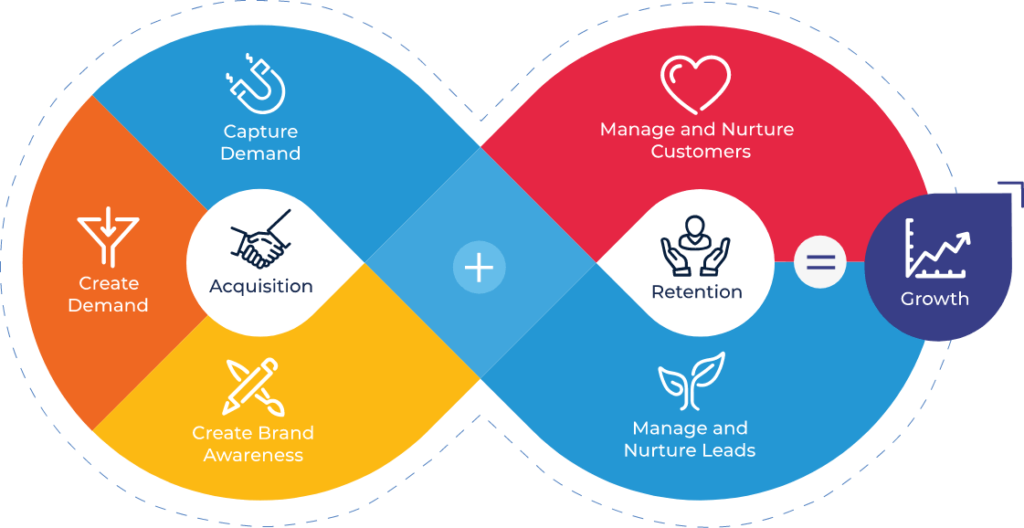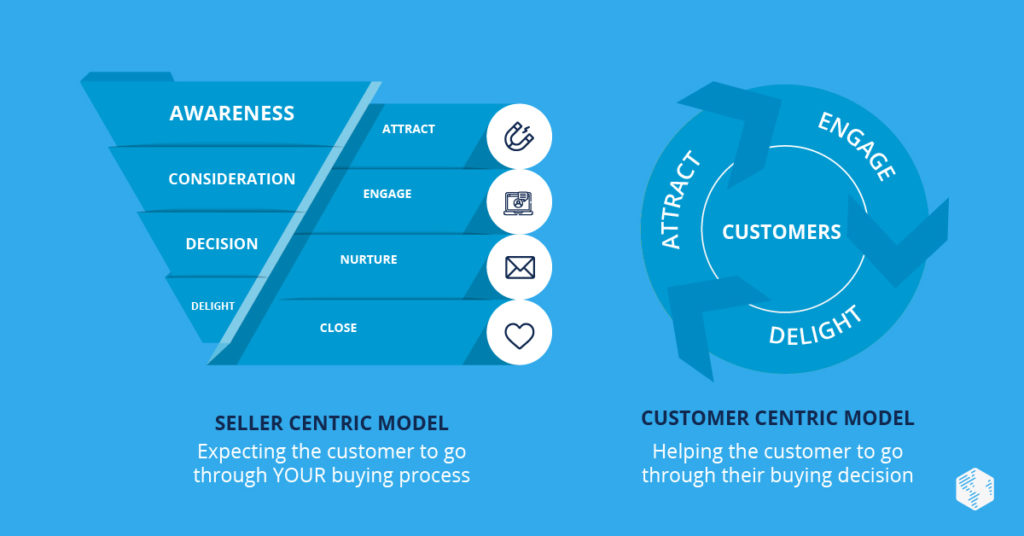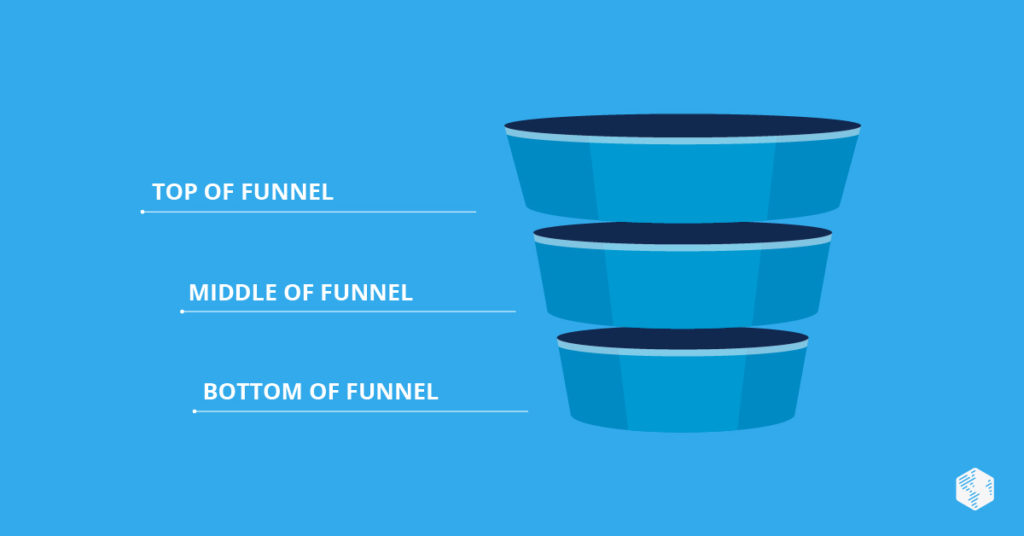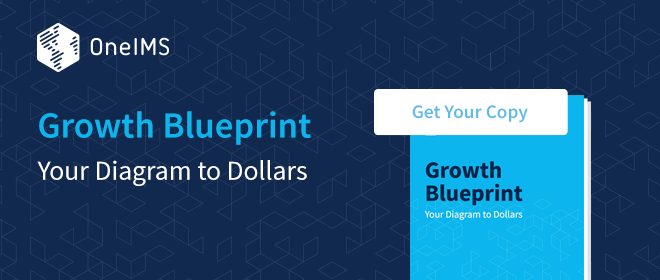Growth is critical to a company’s success. In fact, CEOs and senior business executives rank growth as their most important business priority. And yet, B2B companies often miss one vital step when it comes to their B2B digital marketing strategies: identifying their current growth problem. Often, when it comes to B2B marketing, they will read countless B2B strategies and decide to give some of them a shot. However, if they don’t know why growth has stalled, they won’t find solutions that actually result in B2B lead generation. There is no one-size-fits-all B2B advertising strategy or solution to grow your company. However, there are common pitfalls that block growth that you can avoid.
In this article, we’ll share the growth formula that we have used at OneIMS to drive systematic and predictable growth for dozens of B2B companies. We’ll also get into detail about the most common growth problems for brands. And then, we will provide the B2B growth marketing strategies your business needs to succeed.
The B2B Growth Marketing Formula
It’s natural to get excited about how SEO or Google Ads can grow your marketing funnel. And these approaches do, in fact, work wonders for many companies that we work with. However, they do so because they are used strategically to address an underlying growth problem. This level of clarity is what we want for you and your B2B marketing campaigns.
That’s why we constantly reference our growth formula when assessing opportunities for growth.
Identify the components of your business that might need work first. You can worry about the campaigns and strategies to fix them later (in fact, we have a section dedicated to that later on).
Growth is fueled by acquisition and retention. Within these two categories, there are distinct areas of focus.
Acquisition:
- Create brand awareness
- Create demand
- Capture demand
Retention:
- Manage and nurture leads
- Manage and nurture customers
Each area of focus must run on all cylinders for a virtuous loop of growth to take shape. Companies, therefore, must give some TLC to each part of the B2B growth marketing cycle to grow sustainably and predictably.
The Foundation of Growth: Retention
While the lion’s share of B2B growth content skews toward acquisition, this can be a strategic mistake. Successful leaders of SaaS brands know there can be no growth without retention.
As the former VP of Growth at Hubspot, Brian Balfour was wildly successful at B2B digital marketing. In his list, “10 Reasons Why Companies Fail At Growth”, he ranks not focusing on retention at the top of the list.
“You can hide retention problems for a while by increasing acquisition at the top of the funnel. But with poor retention, the end is inevitable.” – Brian Balfour, former VP of Growth, Hubspot
It doesn’t matter how impressive your acquisition funnel is, if you don’t keep your customers, your company won’t grow. In other words, retention is the foundation of your growth.
Retention also extends to how well you manage and nurture your leads. We’ve seen many companies erroneously believe that their acquisition campaigns were total failures because they didn’t drive new sales. What was really failing these companies, though, was their ineffective lead nurture system.
Technology, like Hubspot, lets you automate lead nurture in a way that drives results. However, it is not uncommon for a B2B agency to fail to take advantage of this kind of technology fully.
The Two-Sided Nature of Acquisition
One of the main acquisition problems that we encounter is that businesses are only capturing current demand. We can almost guarantee that this single focus will not lead you to the acquisition goals you are looking for.
Broadly speaking, there are two acquisition approaches:
- Capture current demand
- Create demand
When leaders at an organization present us with a self-diagnosed growth problem, they typically already have solutions in mind. “I need more traffic and sales. I want to do SEO and Google Ads,” is a common sentiment that we hear during marketing consultations.
However, without a cohesive B2B growth marketing strategy, these tactics will only capture current demand. If you want to be an actual brand authority and subject-matter expert, you must create demand. Capture customers who don’t yet know they need you through inbound marketing and demand generation.
Acquisition Deep-Dive: Capture and Create Demand
To identify what your acquisition solution is, you must first identify your acquisition problem. Is it an awareness problem? Is there enough market share left? Is it a demand generation problem?
In our many years guiding the marketing strategy for B2B brands, the most common problem we encounter is a lack of awareness. Typically, the symptoms of lack of awareness sound something like this:
“If only people knew our business exists. Our products and services are superior to anything else. There is nothing like what we’re offering.”
Sound familiar? Then you, too, have an awareness problem.
Many brands want to work solely on B2B growth marketing campaigns that fix the bottom of their acquisition funnel. However, if you have an awareness problem, you also need to focus on the top of your acquisition funnel, where people who have a problem but are not yet aware of the solution (i.e. your product or service). This is especially true if your product category is innovative and new.
The Acquisition Funnel’s Various Phases
As SiriusDecisions discovered, 67% of the buyer’s journey is conducted digitally. Forrester Research uncovered that most executives look for solutions online when they’re trying to solve a business problem.
It’s not a shocking revelation that you should be part of your customer’s journey as they seek information online. However, if you can pinpoint the best place to appear in your customer’s journey, you can uncover significant growth opportunities.
Your content strategy should address where your customer is on their buyer’s journey and what type of content will address their needs and attract them. And yes, this content strategy should be documented. According to The Content Marketing Institute, only 41% of B2B marketers in 2020 had a documented strategy. However, 69% of the most successful respondents did.
Your content strategy should address where your customer is on their buyer’s journey and what type of content will address their needs and attract them. Share on XCustomers who are starting to articulate their problems are at the top of the funnel. They might not be solutions aware yet. By the time they are in the middle of the funnel, they are aware of various solutions. At the bottom of the acquisition funnel, they are comparing products and pricing. The earlier you show up in their buyer’s journey, the more influence you have over them.
Create demand to:
- Dictate buying criteria to the prospect
- Educate prospects about a solution they aren’t aware exists
- Fix the top of the acquisition funnel problem
Capture current demand to:
- Compete for prospects who have buying criteria in mind
- Get discovered by prospects who are comparing solutions
- Fix the middle and bottom of the acquisition funnel
Customers Must First Admit They Have a Problem
If your product is a category creator, congratulations! According to Harvard Business Review, it can be a very lucrative endeavor. There is one caveat, though: the onus is on you to find your target customer to build awareness and create demand.
Typical search marketing tactics don’t work for category creators because people aren’t searching for a solution. They are not even problem aware, let alone solution aware.
An example that comes to mind is a client that created a harness for pets about to undergo surgical treatment. This harness not only made Fido more comfortable, but it also monitored his recovery. The problem? No one knew it existed. Veterinarians were not Googling “surgery harness for veterinarians” because they were accustomed to the solutions they had.
Because of this dilemma, capturing demand would definitely not help this company grow. We had to create demand.
Even if you are in a known product category, creating demand is still a great way to pick up market share that your competitors are leaving behind. There are often a lot of people who are problem aware, but not yet solution aware.
Blogs are a great way to broaden your keyword bucket and capture prospects who are problem-aware. For example, if you’re a CRM tool, you might want to create a blog post entitled: “5 Ways to Capture Real Estate Leads.” Include your CRM tool on the list, and you’ll become discovered by prospects that are not solutions aware.
Retention Deep-Dive: Manage and Nurture Leads
Depending on your industry, it can be 5 to 25 times more expensive to acquire a new customer than it is to retain one. Retaining customers is a critical part of any company’s growth.
Another important aspect of retention for B2B companies is lead nurturing. It’s often an underserved component of growth. While many SaaS companies employ product marketers to keep customer churn as low as possible, typically, lead nurturing does not receive as much focus.
Marketing Sherpa has identified that “79% of marketing leads never convert to sales.” A lack of lead nurturing is cited as “the most common cause for this poor performance.”
Subpar lead nurturing has been the culprit behind many companies’ mediocre sales numbers. We often see organizations rely on more old-school lead nurture methods that waste a prospect’s time and ignore the buyer’s journey entirely.
How do you know lead nurturing is a part of your growth problem? We will list 8 common pitfalls and let you be the judge.
8 Common Lead Nurture Pitfalls:
1. There is no system in place to manage and nurture leads effectively
If you don’t have a marketing automation system in place, you’re not getting the most out of your leads, and you’re losing sales because of it.
Our favorite marketing automation platform is Hubspot. But whatever platform you choose, it should allow you to create a standardized and agreed-upon lead-scoring criteria. This will empower your entire organization to prioritize leads in a strategic way. Anything less than this is haphazard and ineffective.
2. Customer profiling is not used or is under-used
Not all your leads are created equal, and they should not be treated as such. That’s where profiling comes in. Profiling lets you sort and segment your leads into categories that make lead nurturing effective.
In Hubspot, you can input what your ideal customer looks like. Hubspot will then flag you when someone matching that profile enters your system.
You should have buy-in across your entire organization regarding your ideal customers’ attributes. Then develop a systematic way to flag leads that match your ideal customer profiles.
3. The entire company isn’t in sync or using best practices consistently
Every person at your organization should correctly update lead records in an automated way or, if necessary, a manual way.
Sales and marketing team members should also agree on the definitions for a sales qualified lead (SQL) and a marketing qualified lead (MQL). For instance, if someone schedules a demo, it’s an SQL, whereas someone downloading an ebook is an MQL.
4. Unnecessary friction with leads is present
Stop asking leads for information that you can just as easily get elsewhere. There are better ways to engage leads in a way that serves them (not you).
Hubspot can provide you useful information about your lead. You can also use third-party data to supplement what Hubspot knows, along with engagement data from your site. This information will empower you to reach out to leads in a way that makes sense to them.
5. Companies rely only on one medium for nurture
Many brands rely solely on email for lead nurturing. However, you need a multi-channel/ omnichannel strategy to stand out and remain on your lead’s radar. Different people use the internet in different ways. A multi-channel strategy respects that fact.
Retargeting ads, creating effective B2B social media marketing campaigns, and sending direct mail are all viable options. Only sending emails won’t cut it.
6. Boring, irrelevant content is blasted out to leads
A Demand Generation report showed that providing leads with content targeted and personalized for them resulted in a 20% increase in sales opportunities.
Avoid blasting your leads with content that’s not relevant by sorting and segmenting them.
7. Salespeople are the only way to gauge a lead’s interest.
Use whatever data you can leverage to understand whether a lead is interested.
Perhaps your salesperson said the lead is cold because they don’t respond to any emails. But what does the data say? Are they still opening marketing emails and checking out product pages?
Multiple data points will help you make more informed decisions and stop prematurely writing off leads because they aren’t responsive to your sales team.
8. Salespeople reach out too soon.
Marketing and sales must be working together. Salespeople are invaluable resources in closing sales, but reaching out too soon can turn off a recently obtained lead. Use behavioral data, along with clearly defined MQLs and SQLs to make it clear when the best time for your salespeople to reach out is.
The Purchase Funnel Doesn’t Cut It For Strong B2B Growth Marketing Strategies
During the long, convoluted B2B sales cycle, customers will always be at the center of the buyer’s journey. Putting their needs–and not yours–at the forefront of your marketing is, therefore, a good idea. The ROI on empathy is pretty great when you’re playing the long game.
However, most organizations use a linear purchase funnel to understand the next steps they should take with a prospect. As research firm Gartner states, “the traditional linear sales process no longer exists” for B2B companies.
Before signing on as a customer, prospects often have to get buy-in internally, compare pricing, deal with contracts, and so much more. The purchase funnel does not address that reality and was not created with prospects’ needs in mind. Instead, it was created for sales and marketing team members who wanted to have a systematic way to push people through a sales process.
That’s why we recommend that organizations use a flywheel model instead of a funnel when creating effective B2b growth marketing strategies.
Stop thinking about how to push prospects along your funnel. Instead, think:
- How do I delight them?
- How do I engage them?
- How do I attract them?
Nurture your leads in a personalized, targeted way. Figure out their buying signals, behavior on your website, and sales activities. Knowing their behavior will help unearth opportunities to delight and engage them.
Leads will be more receptive if you aren’t trying to push them through a funnel that doesn’t make sense for their buying journey. After all, you’ll be communicating with them for a while. According to MarketingSherpa, 75% of leads buy within 18-24 months.
Elevate how you treat your prospects by using this flywheel approach. Start putting their needs first and watch as your leads warm up to you.
3 Types of B2B Growth Marketing Strategies
By now you hopefully have a sense of what might be causing your growth to stall. And so, we can dive into strategies to address them.
For the sake of simplicity, we place growth strategies into three categories:
- Brand building
- Traffic building
- Conversion building
No matter what strategies you decide upon, declare your SMART goals for them ahead of time. Otherwise, you won’t know whether they’re effective. If you are unfamiliar with SMART goals, it’s an acronym for: Specific, Measurable, Achievable, Relevant, Time-bound.
Let’s unpack the type of campaigns and strategies that are needed to build a brand, traffic, and conversions. You might need to use strategies from more than one of these categories to grow.
B2B Growth Marketing Strategy #1: Brand Building
Want to address your awareness problem? Hoping to become a trusted subject matter expert? Or perhaps you started an entirely new product category and your target customer doesn’t know enough to search for you yet. If either of these ring true, then here is how to build your brand.
Content strategy
The first aspect of your B2B content marketing strategy involves clearly defining your buyer persona.
Is your buyer persona an engineer or a CEO? Where do they congregate online? What topics do they care about? This work will pay off dividends later when you successfully attract your target customer to you with content they care about.
Below you can find an example of a B2B buyer persona, which has details about a record store manager:
Another key component of content strategy is how you’ll get your content in front of your target audience once you start creating it. Relying on Google to rank your content is far too passive. Pay to promote your content and actively seek out opportunities to get noticed.
Content creation
You want the content you create to achieve two goals:
- Establish your thought leadership to your target audience
- Convince visitors on your website to convert
Become a trusted advisor within your industry. Doing so will establish your brand as a go-to expert for your clients. There are many effective forms of content for thought leadership including:
- Blogs
- Whitepapers
- Guides
- Ebooks
- Videos
When your ideal customers are ready to enter the purchase consideration stage, you will be a more attractive solution if they already trust your expertise.
Of course, the content that you create must be worth checking out. Always speak in a way that resonates with your audience and pick topics that you know they care about. If you aren’t a great writer, hire one or partner with a marketing agency that can assist you. According to The Content Marketing Institute, 49% of B2B brands outsource at least some of their content needs.
Brand mentions and placements
You want your expertise to be visible not just on your site, but also on sites where your audience spends time. This type of digital PR provides backlinks (which makes your site rank better in Google) and provides external validation that your expertise is trusted.
Digital brand placements help your target customers find you. Whether you pitch reporters or write bylines for publications, get your expertise out there. Industry awards and directory sites (such as G2 Crowd or Capterra) offer other avenues that’ll drive digital PR placements.
B2B Growth Marketing Strategy #2: Traffic Building
“Build it and they will come,” may work for Field of Dreams, but it in no way should be your strategy after creating quality content. A solid inbound marketing strategy gets your content discovered by the people you created it for.
Optimization
Brands covet search traffic because it has high intent. People go to Google to find solutions.
Get discovered by people who have identified a problem that your company can solve. SEO makes that possible.
The three factors to consider for SEO:
- Site structure
- Backlinks
- Content optimized to rank for keywords
Site structure
Many businesses have a site structure that prevents Google from crawling through all their pages. That means Google can’t find those pages at all. Having the correct title tags, content clusters, internal linking, and other SEO considerations can drive a lot more eyes on your site. If you are completely unfamiliar with SEO, our definitive B2B SEO guide is a great place to start.
Backlinks
The most important factor in Google’s algorithm is backlinks. Backlinks are when another site links to you as a source of information. If your content gets quality backlinks, it becomes a loud signal to Google that your content is worthwhile, which means they will rank it more favorably.
Backlinks are one of the main reasons many B2B companies choose to focus on digital PR. There is a lot of content available online that provides practical backlink tips.
Content and keywords
Lastly, the content that you write must be valuable and optimized for search. Always write for humans, but keep in mind what keywords you’re vying for.
According to Hubspot, 75% of people never make it past the first page of search results. If you want to rank on page one for valuable keywords, aim for long-tail and medium-tail keywords.
Long-tail keywords tend to be longer and more specific search terms rather than the most popular keywords you might think of first. Long-tail keywords are often what people search for when using voice search. Medium-tail keywords have more search volume than long-tail keywords, but are still fairly niche. Highly motivated audiences tend to search both long-tail and medium-tail keywords.
Content Promotion
Even if you employ the best SEO tactics in the world, you still need to promote your content if you want your content to be seen. Don’t wait for Google to find you.
Promoting content that’s valuable to your potential customer ensures they’ll have a positive first impression of your brand. Once these audiences consume content on your site, you can retarget them in the future.
You’ll also want to explore these options:
- Paid social promotion
- Paid search promotion
- Email newsletters
Paid social promotion
Social media platforms have increasingly turned pay-to-play as organic reach continues to decrease for brands. This isn’t all bad though. Paid promotions also let you target your content to people who match your target personas.
Similar to search engine marketing, intent is important when it comes to paid social promotion. People are usually scrolling to pass the time or distract themselves. That moment is not the best time to sell yourself. Instead, provide content that will pique their interest or provide value.
Paid search promotion
Another worthwhile avenue to promote content that you’ve created is pay-per-click (PPC) search advertising. As we noted, medium-tail keywords attract highly motivated searchers. Continue to target them and more popular keywords using Dynamic Search Ads.
Email newsletter
Your email newsletter is another avenue to reach leads. Build your email list and segment it so that you know you’re sending it to people who are receptive to your content.
Content Distribution and Syndication
There are websites and email lists that are hubs for your exact target customer. Increase your brand’s visibility by distributing content through these channels.
Sponsored content pieces and industry publications offer opportunities to reach your customer in a highly targeted way. Content discovery sites like Quora, Taboola, and Outbrain also offer paid opportunities to share your knowledge in a longform way.
B2B Growth Marketing Strategy #3: Conversion Building
Of course, getting traffic is not enough. Ideally, you’re attracting visitors who value the resources you provide enough to provide their contact information. Knowing what different types of content visitors find valuable is crucial to being able to acquire them as a lead.
TOFU, MOFU, and BOFU are what you should think about when building programs for conversion. TOFU means Top of the Funnel. MOFU is your Middle of the Funnel, and BOFU is your Bottom of the Funnel.
While we advise that organizations place customers’ needs into a flywheel (and not a funnel), it is still advantageous to think in terms of funnels when creating content. What types of topics are people looking for based on how problem- and solution- aware they are? Knowing this allows you to deliver information they will find useful.
TOFU:
- Awareness phase
- They are starting to articulate their problem; might not be aware of solutions
- Content should show them how their problem can be fixed
- Suggested content: Social media ads/videos, blog posts, infographics, checklists
MOFU:
- Consideration phase
- They are aware of solutions and starting to compare them
- Content should show why your solution is the best one to fix their problem
- Suggested content: Ebooks, webinars, guides, calculators, case studies, calculators, kits
BOFU:
- Sales phase
- They are ready to purchase or close to being ready
- Content should enable the sales team to effectively do their job
- Suggested content: Product tutorials, product comparison charts, case studies, webinars, consultations, demos, tutorials
As you can see, there might be overlap in the type of content offered in these different phases. However, the topics addressed would differ. For instance, a webinar in the MOFU phase might be about lead nurturing tactics, whereas a webinar in the BOFU phase might be about the specific product details of a CRM tool.
Get Started on Your B2B Growth Marketing Strategy Today
If you have made it this far along, we can safely say you are well on your way to mastering B2B growth marketing.
All the moving components involved in creating effective B2B online marketing strategies might seem daunting. Here are 7 steps you can use to take you forward.
- Identify your growth problem before taking action
- Allow retention to be the foundation of your growth
- Invest resources and time in an automated marketing solution like Hubspot
- Manage and nurture your leads to achieve sales goals
- Create demand and capture current demand
- Use a flywheel to think about your prospects’ needs more than your own
- Create a documented content strategy that addresses the needs of your target persona during different stages of their buyer’s journey
Lastly, with the long buying cycle involved with B2B sales, marketing is a marathon and not a sprint. Patience is a virtue.
If you need help getting started on your next campaign or are in need of B2B lead generation services, please do not hesitate to contact us at OneIMS. The experts at our B2B marketing agency will come up with custom strategies that effectively attract and retain leads for your business.













































